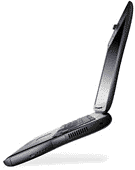Last week I talked about my experience with
the "MainStreet"
edition of the PowerBook G3 Series notebooks. Now I'd like to focus
on the rebuild of a Pismo
PowerBook G3.
This machine represents the pinnacle of G3 PowerBooks, and it's one
of the most coveted. I purchased two nonfunctional Pismo's from
eBay for $55 shipped, knowing that there
may not be a chance of salvaging these machines, but risk is part of
the eBay game.
At first examination, neither would power on, and one had a cracked
LCD screen. I started to take in consideration everything that could
possibly be causing the machines not to chime to life. My options: bad
CPU card, bad power manager, or maybe a bad logic board.
After swapping CPU cards, I discovered that the unit with the
cracked LCD was booting, but that left the problem of the bad screen. I
had never changed a laptop screen before, and I knew I needed help.
Thankfully, ifixit.com has a
fantastic section that shows you how to perform repairs on Apple
notebooks from the G3 PowerBooks on up.
 Screen
installation was very easy. All that was needed was a T6 Torx and a
Philips screwdriver, and it took less than 20 minutes to complete. With
the addition of a 20 GB IBM Travelstar hard drive, I had a fully
functional Pismo. My total cost was less than $120.
Screen
installation was very easy. All that was needed was a T6 Torx and a
Philips screwdriver, and it took less than 20 minutes to complete. With
the addition of a 20 GB IBM Travelstar hard drive, I had a fully
functional Pismo. My total cost was less than $120.
I decided that this machine would replace my Mom's dying HP
OmniBook, a 333 MHz Pentium II laptop, and continue my family's move
away from the Windows platform.
One feature I really like about OS X is the multilingual support
from the get go, something Microsoft doesn't offer with the standard
North American release of Windows XP. Since my Mom is Italian, I
thought that setting up OS X Tiger in Italian would be a good way
to ease the transition from XP and help in everyday scenarios for
her.
This Pismo has a 400 MHz PowerPC 750 CPU with 1 MB L2 cache,
384 MB RAM, and a 20 GB hard drive. I wondered if Tiger would run
poorly with only 384 MB RAM; however my fears were put to rest once I
was up and running. Tiger performed perfectly.
I installed iLife '05, Office 2004, and Solitaire (probably the most
used app on any of my parents' machines), and all performed very well,
even up to spec with my G4 PowerBook. I chose a cookbook program called
Connoisseur
by The Little App Factory for its ease of use and clean interface, and
its proven a great success.
My next step was adding wireless connectivity to the Pismo,
something that's not easily and cheaply done in comparison to a Windows
PC. Apple's AirPort card was priced at $100-$120, and I was unwilling
to pay this much for an 802.11b card, so I did a little research. I
found that certain card manufactures use the same Broadcom chipset
Apple uses in their AirPort Express card, and they would work in
OS X just like an Airport card. After considerable research, I
chose the Belkin F5D7011 802.11g card, and it worked perfectly,
although your results may vary.
Overall, I would rank the Pismo PowerBook a best buy. It's a very
capable notebook with good expansion options. The inclusion of two
FireWire ports is a big plus for video editing aficionados on a budget.
This machine is slimmer and lighter than the WallStreet PowerBooks, which
does have its drawbacks.
The only complaint I have about the Pismo is that it doesn't have
the sturdy feeling that the WallStreet has. This is a minor concern,
however, and given its weight it's necessary.
Pismo runs the latest OS offerings from Apple without a glitch, and
the screen is as good as the one on a modern 14" iBook - with the
exception of the viewing angle, which isn't as good as on modern
notebooks. Still, isn't bad at all.
For someone looking for a starter Apple notebook, this is a good
choice. And if FireWire isn't a necessity, the older, slightly slower
Lombard PowerBook costs
less while performing nearly as well as the Pismo.


 Screen
installation was very easy. All that was needed was a T6 Torx and a
Philips screwdriver, and it took less than 20 minutes to complete. With
the addition of a 20 GB IBM Travelstar hard drive, I had a fully
functional Pismo. My total cost was less than $120.
Screen
installation was very easy. All that was needed was a T6 Torx and a
Philips screwdriver, and it took less than 20 minutes to complete. With
the addition of a 20 GB IBM Travelstar hard drive, I had a fully
functional Pismo. My total cost was less than $120.
